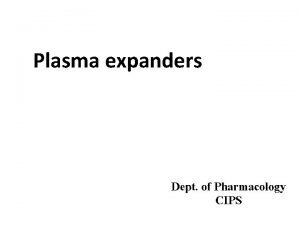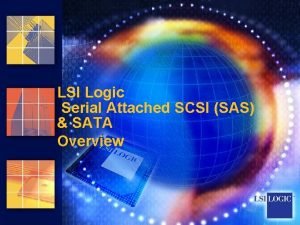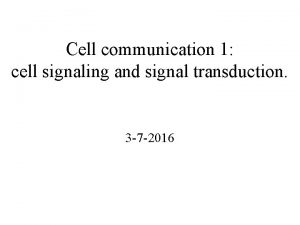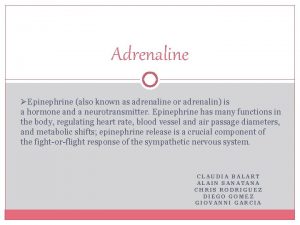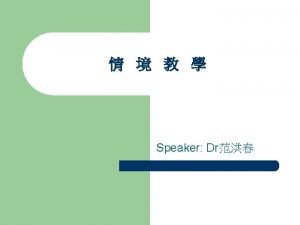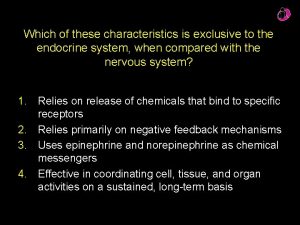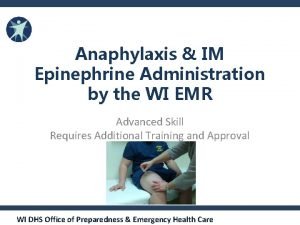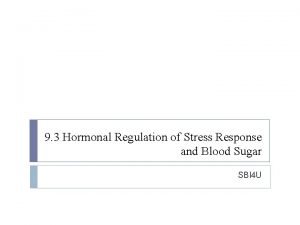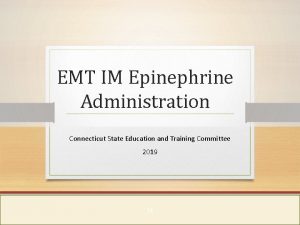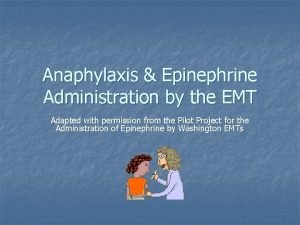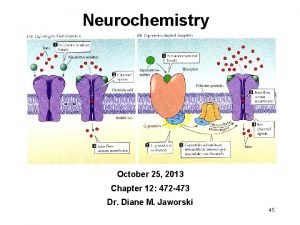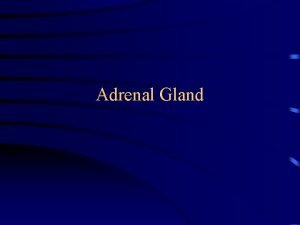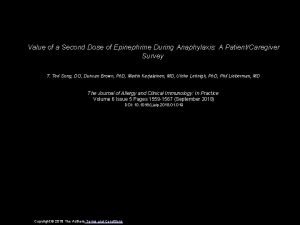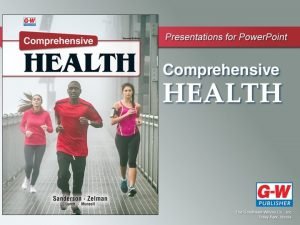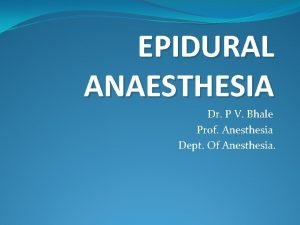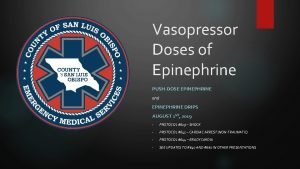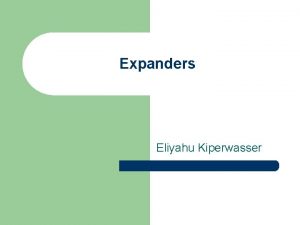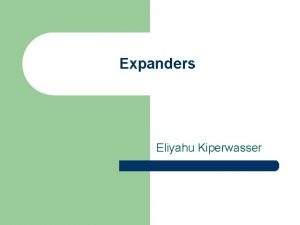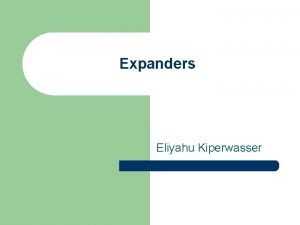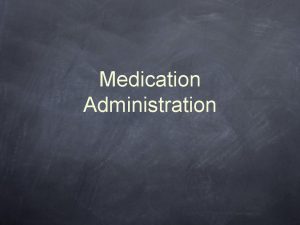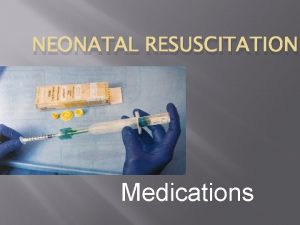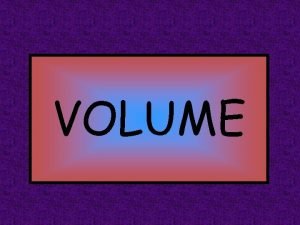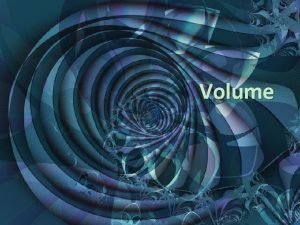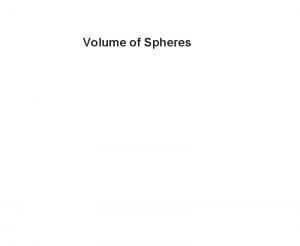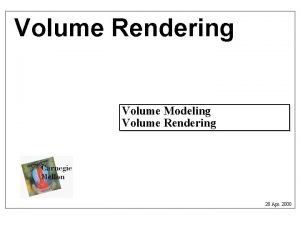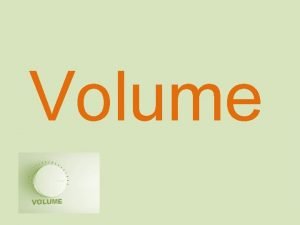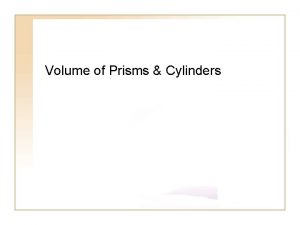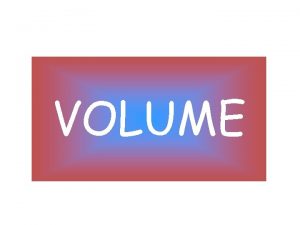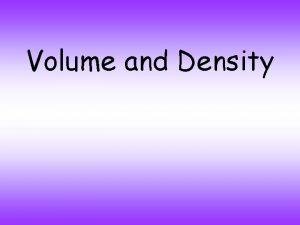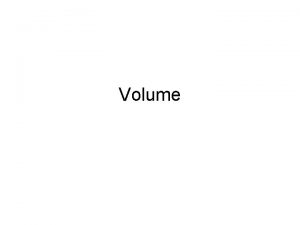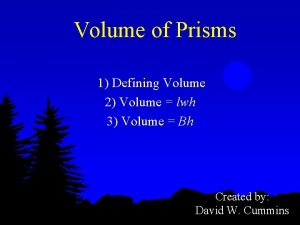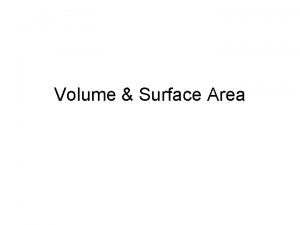MEDICATIONS Medications l Epinephrine l Volume expanders l






















- Slides: 22

MEDICATIONS

Medications l Epinephrine l Volume expanders l Sodium bicarbonate l Naloxone l Dopamine

Neonatal Resuscitation No role of l l Atropine Calcium Dexamethasone Dextrose

Epinephrine Indications l HR < 60 per minute despite 30 seconds of BMV plus chest compressions

Epinephrine l l l Formulation Dilution Load Dose Route Rate 1: 10000 (Ten times) 0. 2 ml in 1. 8 ml 1 ml (in 1 ml syringe) 0. 1 -0. 3 ml/kg IV (preferable) Rapid bolus IT * - use only if IV access is not available; dose of up to 1 ml/kg to be used; Efficacy ?

Epinephrine l Effect : Inotropic, chronotropic, peripheral vasoconstriction l Expect : HR > 60 within 30 seconds

Epinephrine Follow up: if HR < 60 l l Repeat epinephrine q 3 -5 minutes Ensure: effective ventilation effective chest compressions endotracheal intubation (if not done already) l Consider using volume expander l Consider using sodium bicarbonate

Volume expanders Consider l l Pallor persisting after oxygenation Weak pulses, good heart Tachy / bradycardia No improvement despite effective ventilation, chest compressions & Epinephrine

Volume expanders l Normal saline l Ringer’s lactate l Whole blood (O Neg cross matched with mother’s blood)

Normal saline Indications l Evidence or suspicion of acute blood loss with signs of hypovolemia and/or baby responding poorly to resuscitation

Normal saline l Dosage 10 ml/kg l 40 ml in syringe or infusion set l Route IV- umbilical is best l Rate over 5 -10 minute

Volume expanders l Effect : Volume expansion, correction of metabolic acidosis l Expectation : pallor l Follow up : If signs ofhypoperfusion persist, repeat volume expander, consider sodium bicarbonate or dopamine Better BP & pulses, less

Sodium bicarbonate Indications l Prolonged arrest that does not respond to otherapy l if ABG shows metabolic acidosis with normal Pa. CO 2

Sodium bicarbonate l Preparation 0. 9 m. Eq (approx. 1 m. Eq)/ml l Dilution 1: 1 dilution l Load 10 ml of diluted solution l Dose 2 m. Eq/kg of diluted solution l Route IV; Never through ET tube l Rate Slow over 2 minutes or more @ not >1 m. Eq/kg/min

Sodium bicarbonate l Effect : Control of metabolic acidosis; volume expansion l Expectation : HR > 100 within 30 seconds l Follow up acidosis : If persistent metabolic Use epinephrine and volume expansion, consider dopamine

Naloxone hydrochloride Indications l Severe respiratory depression after BMV has restored a normal heart rate & color And l A history of maternal narcotic administration within the past 4 hours

Naloxone Preparation 0. 4 mg/ml Load 1 ml in syringe Dose 0. 1 mg/kg (0. 25 ml/kg) Route IV, IM; No intratracheal Rate Rapidly

Naloxone l Effect : Narcotic antagonist l Expectation : Spontaneous respiration l Follow up : If no response, repeat dose

Dopamine l Indication : Persisting evidence of shock l Effects : Increases cardiac output l Expectation : Better perfusion, better pulses

Dopamine l Preparation : 40 mg/ml l Dose : 5 mcg/kg/min to 20 mcg/kg/min l Route : IV l Rate : Constant infusion for hours to days

- Medications Begin Epinephrine • HR below 60/min after 30 seconds of Volume Expander PPV and chest compressions Sodium Bicarbonate Dopamine Give epinephrine May be repeated every 3 -5 minutes if required HR above 60 Prolonged arrest that does not respond to otherapy Give sodium bicarbondte Discontinue medications Evidence or suspicion of acute May be repeated blood loss with signs of if signs of hypovolvemia hypovolemia persist Give volume expander Evidence of continuing depression

Evidence of continuing depression • Consider other causes, eg: - Pneumothorax - Diaphragmatic hemia - Persistant pulmonary hypertension • Consider starting dopamine • Obtain consultation Naloxone Respiratory depression and history of narcotics administered in the mother within past 4 hours after 30 seconds of BMV
 Plasma expanders
Plasma expanders Scsi vs sata connectors
Scsi vs sata connectors Epinephrine cascade
Epinephrine cascade Racemic epinephrine
Racemic epinephrine Impax epinephrine injection
Impax epinephrine injection Epinephrine function
Epinephrine function Adrenalin is a
Adrenalin is a Racemic epinephrine
Racemic epinephrine Epinephrine and norepinephrine feedback loop
Epinephrine and norepinephrine feedback loop How to draw up epinephrine
How to draw up epinephrine Hypothalamus epinephrine
Hypothalamus epinephrine Emt 6 rights
Emt 6 rights How to draw up epinephrine
How to draw up epinephrine Adrenaline in the brain
Adrenaline in the brain Norepinephrine function
Norepinephrine function Epinephrine second dose
Epinephrine second dose Ward stock system
Ward stock system Common pediatric medications
Common pediatric medications Reconciliation medication meaning
Reconciliation medication meaning Peripheral nervous system medications
Peripheral nervous system medications Chapter 11 medications and drugs
Chapter 11 medications and drugs Chapter 30 administering medications
Chapter 30 administering medications Epidural anesthesia medications
Epidural anesthesia medications
